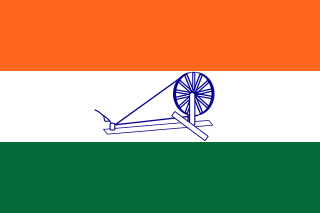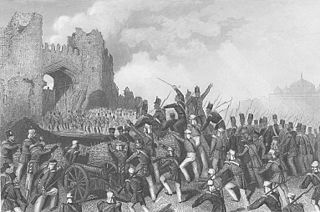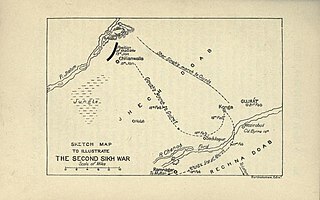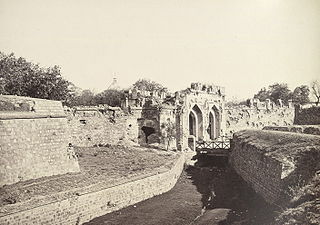The St. Joseph Mutiny was a mutiny which occurred on 17 June 1837 among the 1st West India Regiment of the British Army. It began at the unit's barracks in St. Joseph, Trinidad, then part of the British West Indies.
It was led by recently arrived Africans who had been liberated from illegal slave ships by the Royal Navy and subsequently conscripted into the West India Regiments. Between 60 and 100 soldiers in the regiment participated in the mutiny, seizing arms and ammunition, killing one enlisted soldier and setting fire to the officers' quarters. The Army and Trinidad Militia quickly suppressed the mutiny, killing twelve mutineers; six others committed suicide to avoid capture. Three ringleaders of the mutiny were subsequently executed, while two others were sentenced to death but had their sentences commutated to penal transportation to Australia.
One of the leaders of the mutiny, Daaga, became a folk hero in Trinidad and was an inspiration for the leaders of the Black Power Revolution in the 1960s.

Mutiny is a revolt among a group of people to oppose, change, or remove superiors or their orders. The term is commonly used for insubordination by members of the military against an officer or superior, but it can also sometimes mean any type of rebellion against any force. Mutiny does not necessarily need to refer to a military force and can describe a political, economic, or power structure in which subordinates defy superiors.

The Indian National Army was a collaborationist armed unit of Indian collaborators that fought under the command of the Japanese Empire. It was founded on 1 September 1942 in Southeast Asia during World War II.

The Indian Rebellion of 1857 was a major uprising in India in 1857–58 against the rule of the British East India Company, which functioned as a sovereign power on behalf of the British Crown. The rebellion began on 10 May 1857 in the form of a mutiny of sepoys of the Company's army in the garrison town of Meerut, 40 mi (64 km) northeast of Delhi. It then erupted into other mutinies and civilian rebellions chiefly in the upper Gangetic plain and central India, though incidents of revolt also occurred farther north and east. The rebellion posed a military threat to British power in that region, and was contained only with the rebels' defeat in Gwalior on 20 June 1858. On 1 November 1858, the British granted amnesty to all rebels not involved in murder, though they did not declare the hostilities to have formally ended until 8 July 1859. Its name is contested, and it is variously described as the Sepoy Mutiny, the Indian Mutiny, the Great Rebellion, the Revolt of 1857, the Indian Insurrection, and the First War of Independence.

The Second Anglo-Sikh War was a military conflict between the Sikh Empire and the East India Company which took place in 1848 and 1849. It resulted in the fall of the Sikh Empire, and the annexation of the Punjab and what subsequently became the North-West Frontier Province, by the East India Company.

The Connaught Rangers was an Irish line infantry regiment of the British Army formed by the amalgamation of the 88th Regiment of Foot and the 94th Regiment of Foot in July 1881. Between the time of its formation and Irish independence, it was one of eight Irish regiments raised largely in Ireland. Its home depot was in Galway. It was disbanded following the establishment of the independent Irish Free State in 1922, along with the other five regiments that had their traditional recruiting grounds in the counties of the new state.

The West India Regiments (WIR) were infantry units of the British Army recruited from and normally stationed in the British colonies of the Caribbean between 1795 and 1927. In 1888 the two West India Regiments then in existence were reduced to a single unit of two battalions. This regiment differed from similar forces raised in other parts of the British Empire in that it formed an integral part of the regular British Army. In 1958 a new regiment was created following the creation of the Federation of the West Indies with the establishment of three battalions, however, the regiment's existence was short-lived and it was disbanded in 1962 when its personnel were used to establish other units in Jamaica and Trinidad and Tobago. Throughout their history, the regiments were involved in a number of campaigns in the West Indies and Africa, and also took part in the First World War, where they served in the Middle East and East Africa.

The siege of Cawnpore was a key episode in the Indian rebellion of 1857. The besieged East India Company forces and civilians in Cawnpore were unprepared for an extended siege and surrendered to rebel forces under Nana Sahib in return for a safe passage to Allahabad. However, their evacuation from Cawnpore turned into a massacre, and most of the men were killed. As an East India Company rescue force from Allahabad approached Cawnpore, 120 British women and children captured by the Sepoy forces were killed in what came to be known as the Bibighar Massacre, their remains being thrown down a nearby well in an attempt to hide the evidence. Following the recapture of Cawnpore and the discovery of the massacre, the angry Company forces engaged in widespread retaliation against captured rebel soldiers and local civilians. The murders greatly embittered the British rank-and-file against the Sepoy rebels and inspired the war cry "Remember Cawnpore!".
The Black Power Revolution, also known as the Black Power Movement, 1970 Revolution, Black Power Uprising and February Revolution, was an attempt by a number of social elements, people and interest groups in Trinidad and Tobago to subvert the neocolonial order held over from the days of British slavery and imperialism, and supported by Anglo-American collusive efforts to maintain dominating influence in the Caribbean region.

The 9th Queen's Royal Lancers was a cavalry regiment of the British Army, first raised in 1715. It saw service for three centuries, including the First and Second World Wars. The regiment survived the immediate post-war reduction in forces, but was amalgamated with the 12th Royal Lancers to form the 9th/12th Royal Lancers in 1960.
Reginald Andrew Lassalle, better known as Rex Lassalle, is an alternative medicine practitioner and former lieutenant in the Trinidad and Tobago Regiment who was a leader of an army mutiny in April 1970 as part of the Black Power Revolution.
Makandal Akhenation Daaga was a Trinidad and Tobago political activist and former revolutionary. He was the leader of the 1970 Black Power Revolution. During the unrest he was arrested and charged.

The Cocos Islands mutiny was a failed mutiny by Sri Lankan soldiers against British officers, on the Cocos (Keeling) Islands on 8 May 1942, during the Second World War.

The siege of Delhi was one of the decisive conflicts of the Indian Rebellion of 1857.
The Central India Campaign was one of the last series of actions in the Indian rebellion of 1857. The British Army and Bombay Army overcame a disunited collection of states in a single rapid campaign, although determined rebels continued a guerrilla campaign until the spring of 1859.
The Battle of Badli-ki-Serai was fought early in the Indian Rebellion of 1857, or First War of Indian Independence as it has since been termed in Indian histories of the events. A British and Gurkha force defeated a force of sepoys who had rebelled against the British East India Company. The British victory allowed them to besiege and ultimately capture Delhi.

The Nancy affair, commonly referred to in English as the Nancy Mutiny, was the crushing of a military mutiny in France on 31 August 1790, two years before the final overthrow of the French monarchy. The mutiny was of particular significance in that it illustrated the degree to which the discipline and reliability of the Royal Army had been undermined by thirteen months of revolutionary turmoil.

The British West Indies Regiment was a unit of the British Army during the First World War, formed from volunteers from British colonies in the West Indies.

Blowing from a gun is a method of execution in which the victim is typically tied to the mouth of a cannon which is then fired, resulting in death. George Carter Stent described the process as follows:
The prisoner is generally tied to a gun with the upper part of the small of his back resting against the muzzle. When the gun is fired, his head is seen to go straight up into the air some forty or fifty feet; the arms fly off right and left, high up in the air, and fall at, perhaps, a hundred yards distance; the legs drop to the ground beneath the muzzle of the gun; and the body is literally blown away altogether, not a vestige being seen.
Edward Lanza Joseph was a Trinidadian journalist, playwright and author. He was one of the first English-language poets in British Trinidad, also writing in Trinidadian Creole. He briefly served as editor of the Port of Spain Gazette and published one of the first books on the history of Trinidad.

The Barrackpore mutiny was a rising of native Indian sepoys against their British officers in Barrackpore in November 1824. The incident occurred when the British East India Company was fighting the First Anglo-Burmese War (1824–1826) under the leadership of the Governor-General of Bengal, William Amherst, 1st Earl Amherst.













